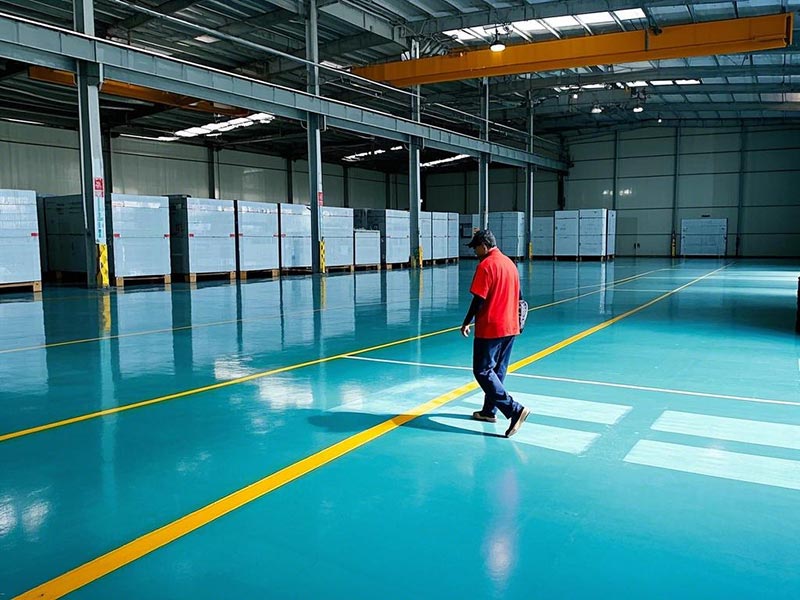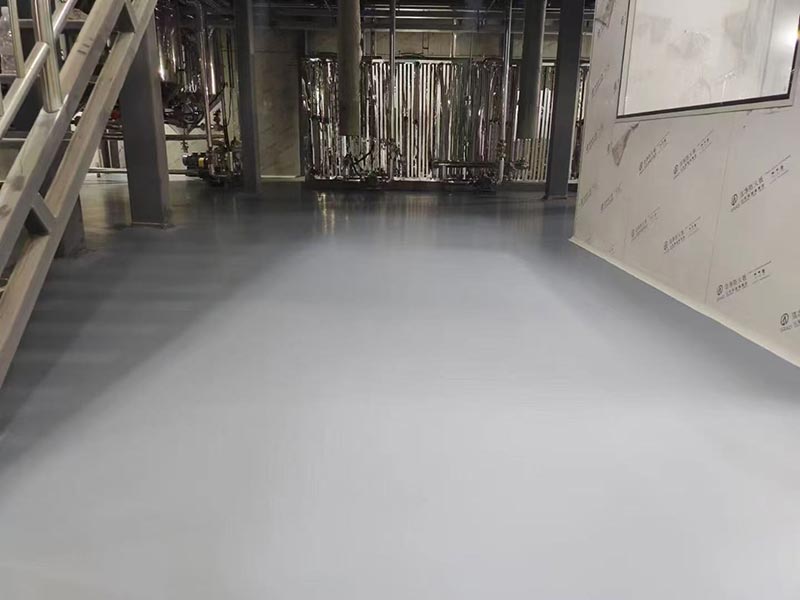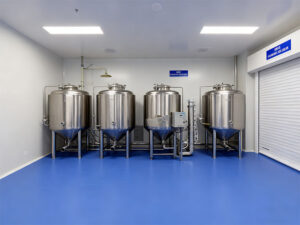Epoxy flooring vs polyurethane are two of the most popular industrial and residential flooring solutions. Both offer dust-proof, anti-slip, wear-resistant, and corrosion-resistant properties, but which is better for your project? While they share some similarities, key differences in durability, flexibility, and application environments make each suitable for specific needs. In this side-by-side comparison, we’ll break down the pros, cons, and best uses of epoxy vs polyurethane flooring to help you choose the right option.
What are epoxy floor paint and polyurethane floor paint?
Epoxy floor paint uses an overall polymer surface layer, and its main components are epoxy resin and curing agent. Epoxy floor paint can be divided into two types: solvent-based and solvent-free. Solvent-based epoxy floor paint will emit a certain amount of volatile organic compounds (VOC) during the production, construction and curing process, but the cost is relatively low; while solvent-free epoxy floor paint is in line with the concept of environmental protection.
Polyurethane floor paint, also known as polyurethane formate paint, refers to a paint that contains a considerable number of urethane bonds in the coating film. It uses polyurethane resin as the main film-forming material, and is composed of pigments, solvents, catalysts and other auxiliary materials. Synthesis of polyurethane resin: The synthesis reaction of polyurethane macromolecules is mainly the reaction between isocyanate and compounds containing active hydrogen atoms. In addition, some minor reactions are involved in the synthesis. The main raw materials of polyurethane floor paint: The main raw materials of polyurethane floor paint are isocyanate, active hydrogen components, solvents, additives, pigments and fillers, etc.
Epoxy vs Polyurethane Flooring: Which Performs Better in Key Areas?
| Category | Epoxy Flooring | Polyurethane Flooring |
| Durability | ✅ Extremely wear-resistant❌ Brittle outdoors (prone to cracking) | ✅ Withstands extreme temps (-40°C to 130°C)✅ UV-resistant for outdoor use |
| Flexibility | ❌ Rigid (low elasticity) | ✅ Highly flexible (prevents cracks) |
| Best For | ✅ Dry indoor spaces (warehouses)❌ Poor in humid/temperature-shift environments | ✅ Humid/hot areas (kitchens, cold storage)✅ Outdoor use (parking lots) |
| Chemical Resistance | ✅ Resists acids/oils❌ Degrades with hot water exposure | ✅ Superior chemical & hot water resistance |
| Anti-Slip Properties | ✅ Moderate grip (add sand for traction)❌ Slippery when wet | ✅ Excellent slip resistance (ideal for wet areas) Top Anti-Slip Industrial Flooring Options: Polyurethane Takes the LeadIn wet industrial environments like breweries or meatpacking plants, polyurethane flooring’s textured surface provides a safer anti-slip solution (0.6+ coefficient of friction) compared to standard epoxy. |
| Cost | ✅ Lower upfront cost❌ Higher maintenance (refinish every 5 years) | ✅ Higher initial cost✅ Low lifetime maintenance |
| Installation Difficulty | ✅ DIY-friendly❌ Slow curing (48+ hours) | ✅ Requires professionals✅ Fast curing (24 hours) |
| Aesthetics | ✅ Custom colors/patterns❌ Yellows outdoors | ✅ Glossy finish, UV-stable❌ Limited color options |
1. Use different raw materials
The two use different raw materials. Polyurethane floor paint is a high-performance floor paint produced with neutral hydroxyl-curing polyurethane and imported weather-resistant curing agent as raw materials, while epoxy floor paint is a floor material composed of epoxy resin and curing agent as basic raw materials. So there is an essential difference between the two.
2. Different flexibility
In terms of flexibility, polyurethane floor paint is more flexible and more elastic to the touch than epoxy floor paint; epoxy floor paint is less flexible, but epoxy floor paint is a floor paint material that is highly wear-resistant, damage-resistant, and aesthetically pleasing.
3. Appearance difference
In terms of appearance, polyurethane flooring has better hardness and higher brightness; while epoxy floor paint has excellent adhesion and a variety of colors for you to choose from, which has a beautifying effect. In terms of color, epoxy floor paint has a variety of colors to choose from and has a beautifying effect.
4. Differences in weather resistance
Epoxy floor paint has poor weather resistance and is intended for indoor use. If epoxy floor paint is used outdoors, it is prone to brittleness, loss of gloss, powdering, and explosion damage. Polyurethane floor paint can be used outdoors. Polyurethane floor paint is not easy to be brittle when used outdoors. It is more suitable for floors with strong durability when exposed to outdoor sunlight, and has better outdoor effects.
5. Differences in construction techniques
In terms of construction technology, the construction technology of polyurethane floor paint and epoxy floor paint are the same. The primer and mid-coat materials are the same, but the topcoat materials are different. Polyurethane floor paint can be applied on epoxy floor paint, but epoxy floor paint cannot be applied on polyurethane floor paint.
6. Difference in hardness
The hardness of the topcoat of epoxy floor paint is higher than that of polyurethane floor paint. The top coating of polyurethane floor coating is a solvent-free polyurethane topcoat with a hardness of 50-80 Shore D. The elastic polyurethane floor coating system uses a solvent-free polyurethane topcoat with a hardness of 40-70 Shore D. These two topcoats have a certain degree of elasticity and have lower hardness than epoxy floor paint.
7. Epoxy vs Polyurethane Cost and Maintenance Comparison
Epoxy Flooring Maintenance Cost: A 5-Year Breakdown. While epoxy floors have a lower upfront cost, their maintenance expenses add up over time. Expect to spend $2-4 per square foot every 5 years for recoating, compared to polyurethane’s near-zero maintenance.
Epoxy floors typically cost less to install than polyurethane floors, but multi-layer epoxy systems may add to the expense. Both types of floors require regular cleaning, but polyurethane is UV-resistant and not prone to yellowing, making long-term maintenance easier. Epoxy floors may need to be refinished every 5 years, while polyurethane is more durable.
Epoxy or Polyurethane Flooring: How to Choose Based on Your Needs?
Choose epoxy resin flooring
1. Dry environment: In the manufacturing industry, a dry and clean working environment is required, such as workshops and warehouses.
2. High clean environment: It is suitable for high clean environment and can provide smooth and clean surface effect, but it is not suitable for use in extensive, heavy load and humid environments.
Epoxy vs Polyurethane for Garages: Which is Better?
For residential garages, epoxy flooring offers a cost-effective and visually appealing solution. However, if your garage faces temperature fluctuations (e.g., snowy winters) or requires frequent washdowns, polyurethane’s flexibility and moisture resistance make it the superior choice.

Choosing a polyurethane mortar floor
1. Environments that are resistant to high temperature hot water and moisture: suitable for places that need to withstand high temperature differences (-40°C to 130°C) and chemicals and need to withstand moisture, such as cold storage, stove areas, wet workshops, underground garages, etc.
2. Places with high safety requirements: Polyurethane mortar floors have excellent anti-skid properties and are suitable for areas that require anti-skid.
Why Polyurethane Flooring Dominates Cold Storage Facilities
Polyurethane flooring’s ability to withstand extreme temperatures (-40°C to 130°C) and resist thermal shock makes it the go-to solution for cold storage, food processing plants, and freezer rooms.

Choosing Between Epoxy and Polyurethane: Garage, Cold Storage & Industrial Use Cases
Through the above analysis of the differences between epoxy floor paint and polyurethane floor paint, I believe you have a more specific understanding. Although polyurethane floor paint is a branch of epoxy floor paint, there are still differences between the two, so they cannot be confused. You still have to choose the appropriate floor paint according to the needs of the ground. When you start a project and are faced with a choice, you need to consider some questions: How high a mechanical load will you need to withstand?
Are there drastic temperature changes in the environment? Does the budget include long-term maintenance costs? If you are an industrial user and require resistance to chemical corrosion, then choose epoxy coating; if you require temperature resistance and elasticity of the ground, then choose polyurethane coating. If you are a home user and require beautiful appearance and customizability, then choose epoxy. If you require moisture-proof and anti-skid, then choose polyurethane coating.
FAQs: Epoxy vs Polyurethane Flooring for Specific Needs
1. Is epoxy suitable for garage floors with heavy equipment?
Epoxy is ideal for heavy equipment garage flooring, especially where it needs to be beautiful, durable, and easy to clean. However, due to the limitations of its fire resistance, when choosing to use epoxy resin flooring, the fire safety needs of the application should be fully considered.
2. What makes polyurethane ideal for cold storage flooring?
Polyurethane flooring can ensure the flexibility of the material even in an ultra-low temperature environment of -40°C, and will not appear brittle, which makes it very suitable for use in cold storage.
The raw material of water-based polyurethane comes from plant castor oil polyol. It has excellent properties such as high and low temperature resistance, good toughness, chemical corrosion resistance, and wear resistance. It is durable and widely used in many fields and is well received. Our flooring solutions not only meet high standards of environmental requirements, but also have excellent features such as environmental protection and durability, making them an ideal choice for industrial flooring materials. Compared with epoxy coating resin materials, polyurethane systems are more wear-resistant, high temperature and hot water resistant, can withstand high temperature environments from -40°C to 130°C, and can withstand hot water steam cleaning above 80°C. They can also maximize stability in high temperature and humid environments and are suitable for use in humid environments. Polyurethane flooring system has high mechanical strength and low elastic modulus. It has high elasticity and is not easy to crack. It is anti-slip and has enhanced wear resistance, allowing it to withstand high-frequency impact and friction.







